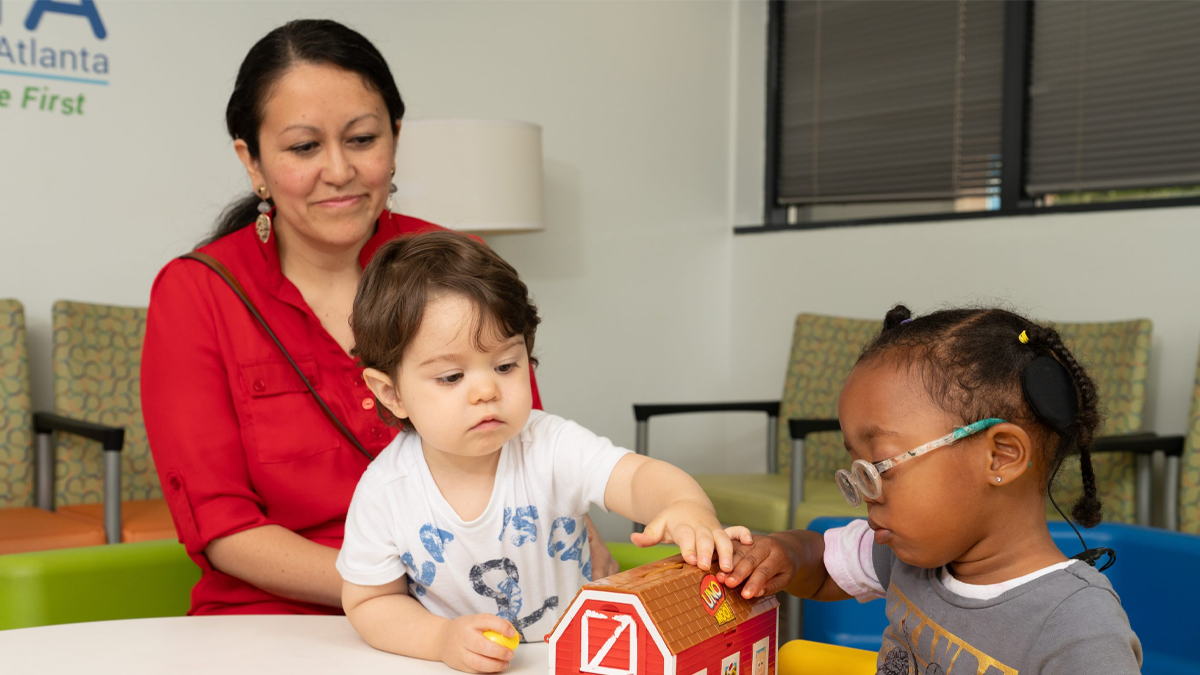What to know
- Hearing loss can affect a child’s ability to develop communication (speech and sign language) and social skills.
- The earlier children with hearing loss start getting services, the more likely they are to reach their full potential.

Early intervention for children who are deaf or hard of hearing
Healthcare providers, such as audiologists, otolaryngologists, and pediatricians have a legal obligation to make a referral to their state's or territory's Early Intervention (EI) program as soon as possible, but no later than seven calendar days after the child has been identified with a permanent hearing loss.
Developmental risk and early intervention
Children who are born deaf or hard of hearing (D/HH) are at risk for developmental delay because they may lack early exposure to an accessible language. However, data reported to CDC show that some D/HH children were not documented as having received early intervention services. In addition, some D/HH children may be born with other conditions that can result in developmental delays. Referring D/HH children to early intervention as soon as possible will help ensure that they can reach their full potential. Early intervention represents the goal of the entire Early Hearing Detection and Intervention (EHDI) process. To realize the benefits of early identification, intervention services need to be:
- Appropriate,
- Individualized,
- Targeted, and
- High-quality.
In addition, intervention services for D/HH children need to be implemented promptly and in a family-centered manner. If a family refuses your referral to intervention services, be sure to document the parents' decision.

What is early intervention?
Early intervention (EI) is a system of services available to children under the age of 3 who are eligible and may have a developmental or language delay, disability, or special health condition that is likely to lead to non-typical development. Evaluation and service coordination are provided free of charge.
If a child isn't developing as expected in certain areas, the family may be able to receive early intervention services from the state's lead agency that works with families and children with different developmental needs. EI services are developmental services that are:
- Selected in collaboration with the parents; and
- Usually provided at no cost (some federal or state laws provide for a system of payments by families, including a schedule of sliding fees).
EI is also known as "Part C of the Individuals with Disabilities Education Act (IDEA)"
EI services may include the following:
- Audiologic services
- Assistive technology
- Counseling/psychological services
- Family training, counseling, and home visits
- Medical evaluation (for diagnostic purposes only)
- Nursing services
- Nutritional services
- Occupational therapy
- Physical therapy
- Service coordination
- Social work services
- Special instruction
- Speech/language therapy
- Sign language and cued speech services
- Vision services
- Transportation
Early intervention process and timeline
The referral process for each state may be different, so it is important to know about your state's EI preferred referral pathway or contact your state's EHDI program coordinator.
There are 5 stages in the EI process:
1. Initial Referral and Identification
When an EI program receives a referral, information about the reason(s) for the referral and the results of any screening or assessment(s) will be collected. A service coordinator is then assigned to contact the family to:
- Provide information about the program,
- Gather family concern and child information, and
- Determine interest in scheduling an initial visit.
2. Intake and Family Assessment
A service coordinator meets with a family to:
- Explain the program,
- Conduct developmental screening (if appropriate),
- Determine with family whether other evaluation is needed, and
- Identify any concerns and availability of resources and set priorities.
3. Child Assessment
The EI program determines enrollment eligibility and coordinates with an evaluation team to determine if further evaluation is needed. If found to be eligible, the EI program will contact the family to schedule an Individual Family Service Plan (IFSP) meeting.
4. Individual Family Service Plan (IFSP) Development
The EI program team develops an IFSP with the family that integrates the following:
- Parents; concern and priorities
- Functional and measurable outcomes for the child
- Service identification and establishment of timeline for the services
5. Service Delivery and Transition
The service coordinator ensures that providers are timely in delivering services specified in the IFSP. The coordinator also ensures:
- Transition services are provided when child reaches 3 years of age
- Coordinated, smooth transition to a Local Educational Agency
Eligibility
Eligibility for EI services varies from state to state. Each state sets its own eligibility requirements. Depending on the type and/or severity of the hearing loss, some D/HH children may not be eligible to receive Part C services.
Note: Refer a child diagnosed D/HH even if
- You are unclear about eligibility for a specific case, or
- The child is 3 years of age or older.
Even if the family is found to be ineligible for services, the EI case coordinator will be able to share other resources with the family.
Locate your early intervention program
To locate your EI program, contact the Early Childhood Technical Assistance Center or your state EHDI program.
Resources
- Provider's legal obligation (2011 Part C regulations:§ 303.302)
- National Center on Hearing Assessment and Management
- Part C of the Individuals with Disabilities Education Act (IDEA)
- American Speech-Language and Hearing Association
- The Early Childhood Technical Assistance Center
- Individualized Family Service Plan
- The Early Intervention / IFSP Process
- CDC's Hearing Screening and Follow-up Survey
- Joint Committee on Infant Hearing position statement
